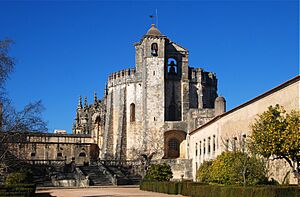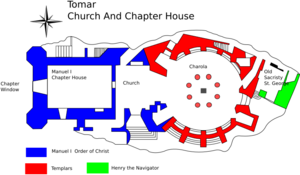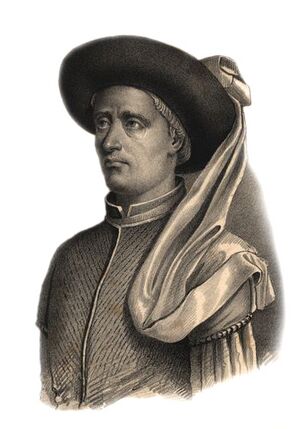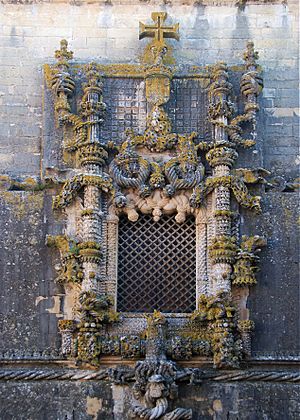History of the Order of Christ facts for kids
Quick facts for kids Order of Christ (Portugal)Military Order of the Knights of Christ Real Ordem dos Cavaleiros de Nosso Senhor Jesus Cristo |
|
|---|---|

|
|
| Active | 1318–present |
| Allegiance | Portugal |
| Type | Western Christian military order |
| Nickname(s) | Order of Christ |
| Attire | White mantle with a red cross |
| Battle honours | Crusades Reconquista |
The Military Order of Christ was a special group of knights in Portugal. It was founded in 1318. This order was actually a continuation of the famous Knights Templar. They kept working from their main base in Tomar, Portugal.
Many people thought the Templars were just renamed by King Denis of Portugal. But the Templars simply moved back to their old home at Tomar Castle. This castle was a special area given to the Templars. They changed their name to protect their many valuable things. These assets were then given to the Knights of Christ. King Denis helped make this happen with the Church's approval.
The order became a non-religious group in 1789. It was officially ended in 1910. However, it was brought back in 1917 in Portugal. Today, it is led by the President of Portugal. It is now an award given for great service to the country.
Contents
Templar Knights in Portugal's Past
The Templars started around 1118. They soon set up bases across Europe. These bases helped them support their work in the Holy Land. They arrived in Portugal by 1122. They settled near Braga. There, they received many gifts of land. They also bought more land. This was only a few years after they started in Jerusalem. It was also before they were officially recognized in 1129. The Templars also got land from D. Theresa in 1126. This was before Portugal became a fully independent kingdom. Portugal was the first European country where they settled.
Gualdim Pais was a leader of the Templars in Portugal. He built the Convento de Cristo in 1160. Stories say he chose the spot by chance. He got a sign to build a new Templar fort there. It was on a hill between two rivers. Local legends say the choice was for magical reasons. They believed it was divine inspiration. This was from practices like geomancy. This magical idea is supported by the fact that the spot was one of seven hills. It became known as the "city of seven hills." This was like Jerusalem, Rome, or Constantinople.
The Convento de Cristo shows the Templars' building skills. Its octagonal church was inspired by the Islamic Dome of the Rock. This shrine in Jerusalem was a Templar base. The Dome of the Rock is on the Temple Mount. This is where the Temple of Jerusalem once stood. The Templars believed the Dome of the Rock was a part of the old Temple. This is where their name came from. They used parts of the shrine's design in their art and buildings. This included the seals of their Grand-Masters. The Church of the Holy Sepulchre might also have been a model.
On July 13, 1190, Abu Yusuf Yaqub al-Mansur attacked the Templars in Tomar. He was the King of Morocco. This event proved the Templars' military strength. It showed they were vital for defending northern Portugal. Pais died in 1195. He had led the order for 50 years.
The Order's Beginning
The Templar order was ended by Pope Clement in 1312. After this, King Denis decided to create a new order. It was for the knights who had lost their place. He started the "Christi Militia" in 1317. Some say it was August 14, 1318. Pope John XXII approved this new order. He did so with a special paper on March 14, 1319.
After four years of talks, Pope John XXII issued another paper. This allowed Denis to give the Templars' property to the Order of Christ. This happened in 1323. The knights of the new order promised to live simply. They also promised to obey the king. It is not clear how many Templars joined the new order. Some historians say the Order of Christ was just the Templars with a new name. Others see it as a mostly new group. The first Grand Master, Dom Gil Martins, had been a knight in the Order of Aviz.
The Order of Christ first had its home in Castro Marim. This was in the Algarve region. In 1357, the order moved to Tomar. This town was near Santarém. It was the former home of the Knights Templars in Portugal. Other sources say the move happened in 1366. This was under the sixth Grand Master, Dom Nuno Rodrigues.
After 1417, Prince Henry the Navigator became the order's Grand Master. This was at the request of King John I of Portugal. Prince Henry led the order from 1417 to 1460. He was born in 1394. He was the king's third son. During this time, Duarte I and Afonso V were Kings of Portugal. In 1433, King Duarte I gave the Order special "Sovereign" status. This was not over lands they already had. It was over any lands they might conquer in the future.
In 1455, Pope Calixtus III confirmed that Afonso V could expand his power. He allowed the king to choose three bishops in areas ruled by the Order. In 1460, King Afonso V gave the Knights of Christ a 5 percent tax. This was on all goods from the new African lands. Prince Henry used money from the Order of Christ. He started the Navigator's school in Sagres. This prepared the way for Portugal to become a powerful sea nation. From this village, the first big voyages of the Age of Discoveries began.
After Henry, the royal family held the Grand Master position. Henry helped settle the Azores and Madeira islands. His goal was to sail south beyond Cape Bojador. This was south of the Canary Islands. During Prince Henry's time, two Gothic cloisters were built. These were at the Convent of Tomar. Henry was also the Duke of Viseu. He was a member of the Knights of the Garter. Henry had a huge impact on history. He arguably started Europe's interest in exploring new lands. This changed the world for the next four centuries.
The cross of the Order was on Portuguese ships. It sailed with them to India, Brazil, and Japan.
Prince Henry was followed as governor of the Order by Prince Ferdinand. He was the son of King Edward I.
In 1484, Emanuel, Duke of Beja, became the 11th Governor of the Order. The rules of the order were becoming less strict. So, Pope Alexander VI changed the vow of celibacy in 1492. Knights could now be married. In 1496, they were freed from celibacy. In 1505, they were freed from the vow of poverty. But they still had to give a part of their income to the Order. This was one-third of their earnings. This money was for building and supporting the Tomar Cloister. Priests of the order still had to follow all three vows. Also in 1501, Pope Julius II changed the poverty vow. It became a tax called the meia-anata. For the Order of Christ, this tax was three-quarters of their yearly income.

Manuel I of Portugal wanted to be Grand Master. He got this title from Pope Leo X in 1516. King Manuel, João's successor, sent Vasco da Gama to sail around Africa to India. Vasco da Gama was a member of the Order of Christ. He sailed in 1497 and reached Calicut. By the end of King Manuel's rule, the order had 454 bases. These were in Portugal, Africa, and India. Manuel also added a lot to the Order's main building in Tomar. He ordered the church of Tomar to be made bigger. It went beyond the castle walls. The Charola was opened up. A grand nave was added for the choir and sacristy. This became known as the chapter house. The order also slowly changed during Manuel's rule. It went from being a religious group to a royal institution.
Manuel's son did not automatically become the leader of the order. He needed approval from Pope Adrian VI in 1523. Thirty years later, John III gained "Perpetual Administration." This meant he controlled all Portuguese Military Orders. This included the Order of Christ. So, the Grand Master position went to the King. This was approved by Pope Julius III in 1551. To manage these orders for the king, John III created a special council. It was called "Mesa das Ordens."
Challenges and Changes
Some experts say that in 1522, the Order split into two parts. One was religious, under the Pope. The other was civil, under the king. They say it remains this way today. However, there is not much proof for this. In 1523, John III formed a group for the Order. He gave Fra António, a Spanish monk, the power to reform the Order. The new rules were approved by the Friars in 1529.
The Grand Prior was removed from his job. All priests and religious members of the Order had to return to living in the convent at Tomar. They also had to wear the Order's habit and cross. Some religious friars were convinced to leave. Others were forced out. António of Lisbon became the Prior. He is blamed for damaging the tombs of Templar Masters. He is also blamed for destroying old documents of the Order. Years later, António was also accused of forcing the rules of the Council of Trent on the Order of Christ. He was also accused of ordering two autos-da-fé. These were the first and only ones held in Tomar. They involved four people being executed. Many others were punished. This included New Christians. It is also said that papers and books were burned. The Portuguese Inquisition started in 1536. This was after the king sent a diplomatic group to the Pope. This group was led by Baltazar de Faria, a friend of Anthony. After his death, Baltazar de Faria was buried in the Convent of Christ in Tomar by Fra António. In 1567, António convinced Pope Pius V to give him control of all the order's convents.
Around 1530, the cross and the rose were linked in the Convent of the Order of Christ. This was before the first Rosicrucian manifesto was published. Three carvings are on the vault of an inner room. This room is thought to have been for initiation. It had seven steps, seven carved rose-crosses, and a sun design. It also had a small underground chamber or "tomb of initiation." In some of the carvings, a rose flower is clearly seen in the center of the cross.
King Sebastian's Efforts
King Sebastian tried to undo the changes made by brother Antonius of Lisbon in 1574. Antonius had convinced Pope Pius V to give him control of all the order's convents in 1567. King Sebastian protested this. He got his position as Grand Master confirmed. Because of this, the religious members of the Order were separated. They became either lay (non-religious) or military members.
Philippine Changes
Between 1580 and 1640, there was another attempt to change the order. New rules were made in 1619 at Tomar. They were officially put into practice by Philip III of Portugal in 1627. To join the order, a person had to be of noble birth. They also needed two years of service in Africa. Or, they needed three years with the fleet.
The Order Becomes Non-Religious
Pope Pius VI (1789) and Queen Mary I made the last attempt to reform the order. This reform made the convent of Tomar the main home of the whole order again. The ruler of Portugal was still the Grand Master. But instead of a convent leader, there was a grand prior of the Order. In 1789, the Portuguese Order lost its religious purpose. Queen Mary made it a non-religious group. Since 1789, the members included the Grand Master and Great Commander. There were also six Knights of the Grand Cross. There were four hundred and fifty Commanders. And there was an unlimited number of Knights. Foreigners did not have to follow the rules. But they also could not share in the Order's money. Only Catholics from noble families could join the Order. The Order of Christ also continued in Brazil. It lasted until the end of the Monarchy there in 1889.
In 1834, the government of Portugal became anti-Catholic. This was after King Miguel lost the Civil War. Under the new government, the order lost its properties. The old Military Orders were changed by new laws. They became simply "Orders of Merit." The special rights that members of the old military orders once had also ended.
In 1910, the Portuguese monarchy ended. The Republic of Portugal ended all the Orders. Only the Order of the Tower and Sword remained. However, in 1917, after the Great War, some of these Orders were brought back. They became "Orders of Merit." These were to reward great service to the country. The President of the Republic became the Grand Master. The Military Order of Christ, along with other Portuguese Orders of Merit, had its rules updated many times. This happened during the First Republic (1910–1926), then in 1962, and again in 1986.
Today, the order is managed by a Chancellor and a Council of eight members. These members are chosen by the President of the Republic. They help the President as Grand Master. They handle all matters about the Order. The Order can be given to civilians and military members. It can be given to Portuguese people and foreigners. This is for great service to the Republic. This includes work in parliament, government, diplomacy, courts, public offices, or civil service.
See also
- Order of Christ (Portugal)
- Order of Christ (Brazil)
- Order of Christ (Kongo)
- Supreme Order of Christ





